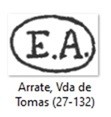
ARRATE Vda de THOMAS
Here is a
Spanish replica of a Smith & Wesson 380 caliber revolver that aroused many
reactions, sometimes contradictory, among the team members.
The R in
the grenade is the final proof for revolvers in Eibar (Spain) between 14.12.1929
and 9.7.1931, one member told me. According to my sources, this is the final
stamp for revolvers during this period, without mentioning the date.
The coat
of arms with a cross of St Andrew (under the crown) is that of the proofhouse of
Eibar 1923 – 1931 : according to my sources, it was used from 14 December 1929
to 9 July 1931.
The
six-pointed B under asterisk: annuals letter of 1928 indicating that the test
was carried out that year (an annuals letter is affixed to all Spanish weapons
tested by the Eibar proofhouse since 1927). That’s correct, but it’s in
(slight?) contradiction with the R in the grenade. But it doesn’t matter.
E.A in
oval under crown could be Emilio Alonso, tells me a member.
The
Spanish EA is probably “Echave y Arizmendi”, patented copier of Smith & Wesson’s
“Top Break”, tells me one member, who later admits that he is best known for his
copies of semi-automatic pistols.
Another
member quotes Jesus Nandrinan :
• EA, Eulogio Arostegui. Also tener las marcas "Blue ",
"E.A." y "Azu - Oscillant".
The
following are also mentioned:
www.littlegun.info/arme%20espagnole/ancien%20artisan/a%20echave%20y%20arizmendi%20gb.htm
Another
summary: "The E A mark may be awarded to at least three manufacturers:
Echave y
Arizmendi
Eulogio
Arostegui
And... if
we trust the Spanish specialists: Arrate, Vda de Tomas!

Judging
by the weapons manufactured, one should perhaps rule out Echave y Arizmendi as
they are more oriented towards automatic pistols.
Eulogio
Arostegui and Tomas Arrate's widow remain on the track.
The
Arrate house had been making a little bit of everything since 1870, including
many revolvers. Targeting the British military market like many others, this
would explain this S&W Top Break model, housed in .455 Eley or .38SW, especially
around 1914... »
Finally,
one member finds that (based on the R-mark in the grenade) the period 1929-1931
is quite late for such a device. We can talk about it... as long as we find the
ammunition, why not...
GP with the whole team.